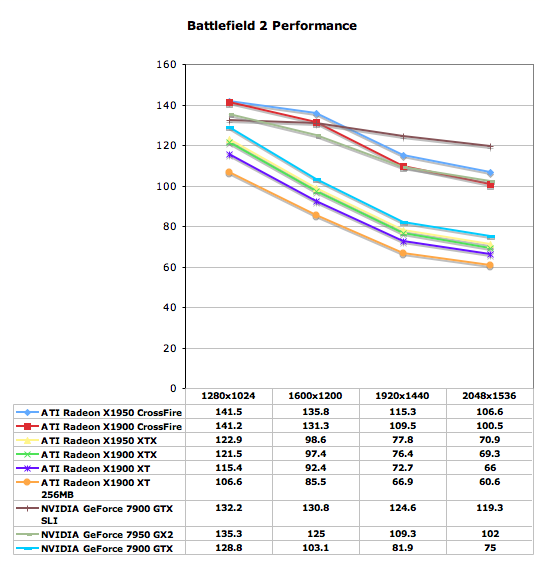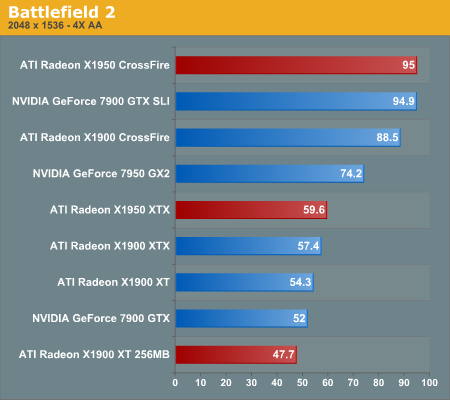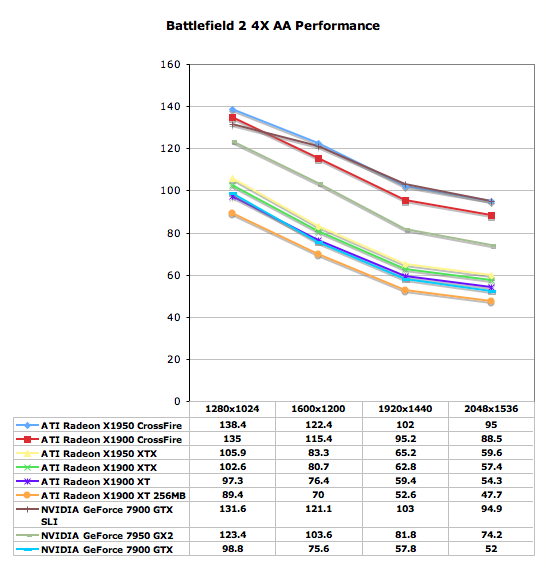ATI's New High End and Mid Range: Radeon X1950 XTX & X1900 XT 256MB
by Derek Wilson on August 23, 2006 9:52 AM EST- Posted in
- GPUs
Battlefield 2 Performance
This benchmark is performed using DICE's built in demo playback functionality with a few added extras built in house. When using the built in demo playback features of BF2, frames rendered during the loading screen are counted in the benchmark. In order to get a real idea of performance, we use the instantaneous frametime and frames per second data generated from a benchmark run. We discard the data collected during the loading screen and calculate a result that represents the actual gameplay that was benchmarked. While DICE maintains that results over 100fps aren't reliable, our methods have allowed us to get useful data from high performing systems.
During the benchmark, the camera switches between players and vehicles in order to capture the most action possible. There is a lot of smoke and explosions, so this is a very GPU intensive Battlefield 2 benchmark. The game itself is best experienced with average in-game framerates of 35 and up.
We ran Battlefield 2 using the highest quality graphics settings we could. Shadows, lighting, and especially view distance are very important in order to best play the game. In our opinion view distance should never be set to less than the max, but other settings can be decreased slightly if a little more performance or a higher resolution is required.

At the very top of the charts the GeForce 7900 GTX SLI manages to maintain just under a 12% advantage over the X1950 CrossFire, indicating to NVIDIA that it may not need to even respond with a new product to combat ATI's launch today at the high end. A single 7950 GX2 offers virtually identical performance to the X1950 CrossFire, showcasing the main strength of the 7950 GX2: its ability to offer dual card performance in a single slot in any platform. The performance advantage the X1950 CrossFire offers over its X1900 predecessor is 6%, definitely not enough to warrant an upgrade.
Single card performance is representative of what we've seen with multi-GPU performance, with the single 7900 GTX outperforming a single X1950 XTX. Note that the 7900 GTX's performance advantage actually grows from one to two cards, thanks to better scaling with NVIDIA's SLI architecture over ATI's CrossFire.
At the very bottom of the chart we've got the X1900 XT 256MB which really puts things into perspective. Being able to deliver 60 fps at 2048 x 1536 itself, most users will be monitor limited before they are GPU limited in games like Battlefield 2; in which case, the clear recommendation here is the $280 X1900 XT (or the similarly priced factory overclocked 7900 GT as we saw earlier in this review).

Although the 7900 GTX SLI performs better at higher resolutions, ATI's X1950 and X1900 CrossFire setups actually perform better at lower, more CPU bound resolutions, indicating greater driver overhead with NVIDIA's SLI. CPU limitations are quite evident at lower resolutions with the multi-GPU setups further reinforcing the idea that if you've got a LCD with a 1280 x 1024 maximum resolution, then you may want to think twice about upgrading to a second GPU.
The CPU limitations seen at 1280 x 1024 start to fade away as we move to 1600 x 1200, where the multi-GPU pack separates itself from the single GPU cards. What's interesting is that, with the exception of NVIDIA's 7900 GTX SLI, the remaining multi-GPU cards have similar resolution scaling curves to the single cards, just at higher frame rates.

When AA gets kicked on, we see the numbers get shaken up a bit. X1950 CrossFire essentially ties 7900 GTX SLI for the performance lead, and the 7950 GX2 drops to the bottom of the multi-GPU pile. Single GPU performance becomes dominated by ATI cards with the 7900 GTX falling to nearly the level of the 256MB X1900 XT. At the same time, it is a nice treat to realize that even the 256MB X1900 XT is playable at 2048x1536 with all the eye candy cranked up.

Our scaling graph doesn't show the same CPU limitedness we saw without AA enabled. The 7900 GTX SLI does see a hint of performance loss due to driver overhead here as well, but otherwise all these cards scale similarly as in the previous test.










74 Comments
View All Comments
SixtyFo - Friday, September 15, 2006 - link
So do they still use a dongle between the cards? If you had 2 xfire cards then it won't be connecting to a dvi port. Is there an adaptor? I guess what I'm asking is are you REALLY sure I can run 2 crossfire ed. x1950s together? I'm about to drop a grand on video cards so that piece of info may come in handy.unclebud - Friday, September 1, 2006 - link
"And 10Mhz beyond the X1600 XT is barely enough to warrant a different pair of letters following the model number, let alone a whole new series starting with the X1650 Pro."nvidia has been doing it for years with the 4mx/5200/6200/7300/whatever and nobody here said boo!
hm.
SonicIce - Thursday, August 24, 2006 - link
How can a whole X1900XTX system use only 267 watts? So a 300w power supply could handle the system?DerekWilson - Saturday, August 26, 2006 - link
generally you need something bigger than a 300w psu, because the main problem is current supply on both 12v rails must be fairly high.Trisped - Thursday, August 24, 2006 - link
The crossfire card is not the same as the normal one. The normal card also has the extra video out options. So there is a reason to buy the one to team up with the other, but only if you need to output to a composite, s-video, or component.JarredWalton - Thursday, August 24, 2006 - link
See discussion above under the topic "well..."bob4432 - Thursday, August 24, 2006 - link
why is the x1800xt left out of just about every comparison i have read? for the price you really can't beat it....araczynski - Thursday, August 24, 2006 - link
...I haven't read the article, but i did want to just make a comment...having just scored a brand new 7900gtx for $330 shipped, it feels good to be able to see the headlines for articles like this, ignore them, and think "...whew, i won't have to read anymore of these until the second generation of DX10's comes out..."
I'm guessing nvidia will be skipping the 8000's, and 9000's, and go straight for the 10,000's, to signal the DX10 and 'uber' (in hype) improvements.
either way, its nice to get out of the rat race for a few years.
MrJim - Thursday, August 24, 2006 - link
Why no Anisotropic filtering tests? Or am i blind?DerekWilson - Saturday, August 26, 2006 - link
yes, all tests are performed with at least 8xAF. Under games that don't allow selection of a specific degree of AF, we choose the highest quality texture filtering option (as in BF2 for instance).AF comes at fairly little cost these days, and it just doesn't make sense not to turn on at least 8x. I wouldn't personally want to go any higher without angle independant AF (like the high quality af offered on ATI x1k cards).